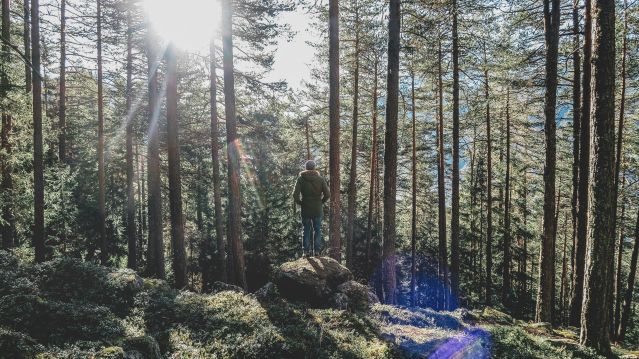Loneliness
The Surprising Ways Solitude Is an Antidote to Loneliness
Time alone is fleeting in our modern world, but it's key to social connection.
Posted June 17, 2024 Reviewed by Devon Frye
Key points
- Amidst a crisis of loneliness and isolation, we’re losing the time and space for solitary quiet reflection.
- Surprisingly, solitude can be a powerful antidote to loneliness.
- When we know ourselves, we are better able to know others.
One Thursday evening, in the early days of the pandemic lockdowns, I was suffering through COVID and an intense bout of pneumonia. I was at home, alone, wondering whether I would survive to see another Thursday. I was exhausted from an endless schedule of Zoom calls and yearning to be in the physical presence of the people that I love.
In that melancholy moment, I looked out at my backyard—a small urban green space in Toronto.
I stepped outside into the light. I started watching the squirrels, chipmunks, a raccoon, and an owl. I fed a squirrel some seeds and nuts from my hand, and I started noticing the squirrel interacting with her children. I started feeding her more, and she brought her children to me, too.
In what felt like a remarkably short period of time, the squirrel ceased being some wild and insignificant other. This was a mother, I realized. I saw the complex web of relationships in my tiny backyard ecosystem.
Suddenly, I didn’t feel so alone.
The Solitude Paradox
“I never found the companion that was so companionable as solitude,” Henry David Thoreau wrote during his time immersed in nature at Walden Pond.
More than a century later, the farmer-philosopher Wendell Berry gave a powerful explanation for how solitude can be an antidote for loneliness. In “the wild places, where one is without human obligation… one’s inner voices become audible.” He continued: “The more coherent one becomes within oneself as a creature, the more fully one enters into the communion of all creatures.”
It’s a counterintuitive idea. Solitude—a state that’s often confused with loneliness—can, in fact, be a powerful antidote to loneliness.
When we know ourselves, we are better able to know others. When we feel at home in the here and now, we feel more at home in the world at large.
An Important Message for Our Times
This is an important message for the times in which we’re living.
We just marked Loneliness Awareness Week. One year ago, the U.S. Surgeon General declared an “epidemic of loneliness and isolation.” In 2023, the World Health Organization officially prioritized the “pressing health threat” of loneliness.
Loneliness—a negative state where a person feels a gap between their preferred and actual levels of social connection—is clearly on the rise. Solitude—a chosen state of being alone for reflection and restoration—should theoretically be more accessible in a time of more aloneness. But the opposite is true. Amidst a crisis of loneliness and isolation, we’re losing the time and space for solitary quiet reflection.
According to Pew Research, nearly one-third of people in the U.S. are online “almost constantly.” Rates are higher among young people. Work-from-home has often blurred the lines between personal and professional life.
As we seek solutions to a crisis of loneliness and isolation, we should consider ways to increase not only traditional social connection but also our capacity for reflection and inner connection.

Find Your Own Style of Solitude
Over recent decades, “mindfulness”—a set of practices for “paying conscious nonjudgmental attention to the present moment”—has gained popularity. But mindfulness doesn’t only mean sitting alone and watching the breath. You can find a form of mindfulness, for example, by putting the phone away in diving deeply into a good book. Give yourself permission to experiment with your own pathways for finding gratitude, pure attention, and connection to the present.
Embrace Nature
My experience in my little urban garden during the pandemic underscores that “wildness” can be more accessible than we sometimes assume. Take in the sunset. Try birdwatching in a nearby park. Tend to the flowers in your friend’s front yard.
Ming Kuo of the University of Illinois has conducted interdisciplinary research on the impacts of nature on human psychology and reports that: “Just playing with soil for five minutes, we can see your parasympathetic nervous activation change—from ‘fight or flight’ moving towards ‘tend and befriend.’”
Part of the experience of loneliness—the sense that one’s social needs are not being met—is an overriding fixation on one’s own needs. Focusing on nature is a way of dethroning the ego, quieting the mind, and feeling gratitude for the broader web of life.
Bring Contemplation to Healthcare
Medical providers are now addressing loneliness through practices like “social prescribing”—wherein health professionals connect patients who are experiencing loneliness with non-medical community services and activities to improve their well-being. Through social prescribing, providers will often recommend patients to participate in group activities like arts or volunteer opportunities. As part of this movement, healthcare providers should consider how to integrate contemplative practices into treatment programs to address loneliness.
Pro-Solitude Policies
In 2017, France enacted a “Right to Disconnect” from work email and other communications after the workday has concluded. Other jurisdictions, including Ontario, have followed suit.
We need policies that affirm our time for rest and renewal. As I work with partners in the coming months to create a Charter for Belonging—a compendium of action ideas for addressing the crisis of social isolation—we’ll be exploring how public policies can promote not only traditional community but ways to bolster connection through personal intentional reflection as well.
There’s now a major push across sectors and societies to boost social connection. But this work risks being counterproductive if it furthers a sense that time in solitude is shameful. Building belonging means cultivating a balance between social connection and personal space. In seeking to address an “epidemic of loneliness,” we can’t create a culture of judgment against time spent alone.
Connection isn’t just a human need. Connection is an art. It’s through time in nature and solitude that we come to know ourselves, to connect with our inner sources of inspiration, and to hone the skills of being able to listen, to care, and to be in relationship with others.
As I discovered during the darkest days of the pandemic, there are sources of connection hidden in plain sight all around us. Let’s invest the time and attention that they deserve.




